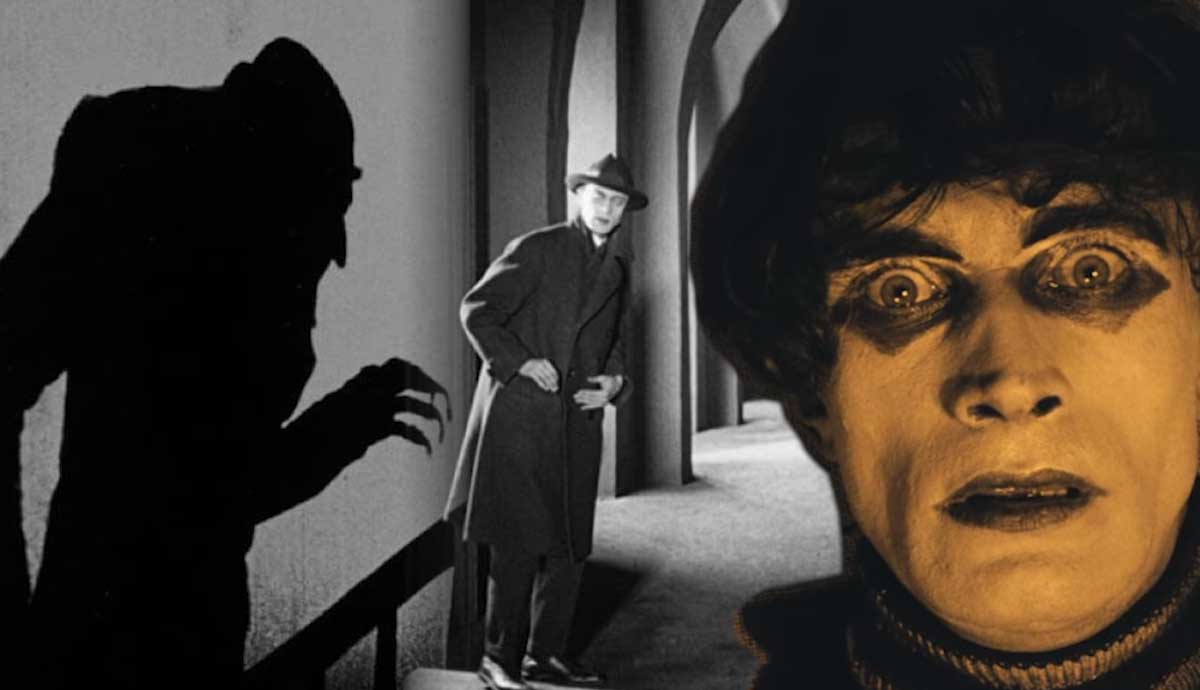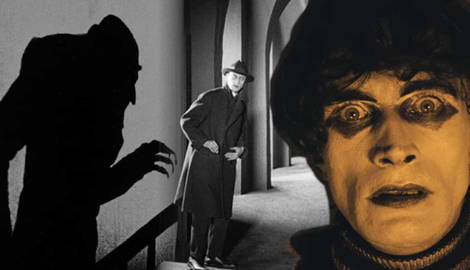
German Expressionism in cinema is known for dramatic camera angles, looming shadows, optical illusions, haunted anti-heroes, claustrophobic cinematography, and shocking twist endings. It’s difficult to imagine what the landscape of cinema would look like today without the breakthroughs of this 1920s film genre. With heavy symbolism and bold dark themes, German Expressionist films quickly took hold of a country reeling from the aftermath of the First World War.
What Was German Expressionism?

German Expressionism was an early 20th-century art movement, wildly influential yet notoriously difficult to pin down. Its cinematic incarnation is an offshoot of the larger Expressionist movement, which had a profound impact on visual arts, theater, literature, and architecture in the early 1900s. Expressionism was influenced by post-impressionist and symbolist artists like Paul Gauguin, Edvard Munch, and Vincent Van Gogh, as well as by African and Polynesian art. It sought to express individual emotions and subjectivities, rather than depict the impressions of a realistic world.

Expressionist artworks often depicted the alienation, anxiety, and sexuality of the modern world. Expressionists used bold and unrealistic colors, jagged lines, and semi-abstract and exaggerated shapes. In theater and literature, Expressionism sought to explore characters’ mental states, often using symbolism, and depicting heightened, exaggerated emotions.

German Expressionist cinema sits at the convergence of these art forms. It developed largely in the 1920s, a decade after the outset of expressionism in visual art and literature. Following the devastation of the First World War, the movement brought to the silent film screen innovative ideas and disturbing stories. The mise-en-scène of these films did not use realism. Instead, it expressed subjective viewpoints, seeking to immerse audiences in twisted narratives and haunting tales. To do this, the authors used distorted, unrealistic set design, bold makeup, experimental camerawork, and chiaroscuro lighting.
The Backstory: World War I and the Weimar Republic

German Expressionism is a deeply psychological film movement. The narratives of crime and corruption that populate expressionist filmography are inextricable from the social and historical background of the First World War and its aftermath. Called the war to end all wars, the First World War changed the world forever. Unprecedented in scale, the conflict had a deep impact on every level of society. Lack of resources and hunger became widespread in Europe, economies went into freefall, revolutions were sparked, empires and kingdoms fell, and new countries were born. Technology saw rapid development in a war that started with mules and ended with tanks, poison gas, artillery fire, and trench warfare.
Close to ten million soldiers died in the four years of conflict. In Germany alone, two million died in battle, while close to twelve million came home with severe injuries. The psychological impact of the war, at the battlefront and at home, was incalculable.

Germany entered the war with unparalleled enthusiasm and ended it as its greatest defeat. By the end, German soldiers and people at the homefront were exhausted, demoralized, malnourished, and traumatized. On the 9th of November 1918, a revolution would bring the fall of the monarchy and usher in a new democratic constitutional republic, one that made several concessions to the military high command and upper classes.
This was known as the Weimar Period or the Weimar Republic. Lasting from 1919 to 1933, this period was rife with conflict and contradictions. The tolls of war, hyperinflation, unemployment, political extremism, and instability plagued Weimar. Still, by the mid-1920s, a slow stabilization of the economy and mending of international relations saw Weimar Germany’s own golden twenties.

Art, culture, and scientific and philosophical innovation flourished in Weimar, emboldened by political freedom. Berlin became a bubbling cultural center of Europe. During these years, cinema saw stunning technological and artistic developments. As Weimar culture grew in creativity and exuberance, the far-right grew ever more bitter and resentful of the Treaty of Versailles and the imaginary loss of German values. The Great Depression of 1929 would bring any progress Weimar Germany had to a halt, and in only a few years, set the stage for the rise of Nazism.
The Cinema of the Weimar Republic

Unlike the rival industries of France, Italy, and the UK, the heavily state-funded German film industry was largely intact by the end of the war. Foreign films had been banned in 1916, which meant that by 1918 the at-home demand for entertainment (and distraction) was high. Around 3500 feature films were produced during the Weimar Period. Cinema was never as popular in Germany as it was from 1919 to 1926. In the 1920s, Germany had the only film industry in the world that could rival Hollywood and, according to many, surpass it in modernity and sophistication.

Weimar cinema was a wide, varied affair, characterized on the whole by stunning creativity and innovation. German Expressionism was only a part of that whole, but its stylistic and thematic breakthroughs were so striking that there are still echoes of it in global cinema today. Plenty of costume films, romances, comedies, adventure flicks, melodramas, and countless other types of movies came out during this time. But it was the twisted narrative and creepy visuals of Robert Wiene’s The Cabinet of Dr. Caligari that would project the anxieties of the postwar psyche onto the big screen for the first time.
The Breakthroughs of Dr. Caligari

Robert Wiene’s The Cabinet of Dr. Caligari came out in early 1920. It follows the story of a carnival doctor, Dr. Caligari (Werner Krauss) who hypnotizes the somnambulist Cesare (Conrad Veidt) and makes him commit violent crimes. From the twisted screenplay to the nightmarish quality of its style, Caligari was dark and visually striking, unlike anything else in the cinema of the time. The mise-en-scène is intentionally distorted and off-putting. The set design is unrealistic, the streets zigzagging mazes, the buildings slanted. The painted-on shadows are jagged and sharp, the makeup, inspired by funeral masks, is heavy and exaggerated, and the acting is deliberately creepy.

The look of Caligari uses expressionist techniques to bring the audience inside the minds of its troubled characters, especially narrator Franzis (Friedrich Feher). Caligari is one of the earliest examples of subjective filmmaking and unreliable narration. It also features one of the first twist endings in cinema. Its themes include anti-authoritarianism, senseless violence, anxieties of the postwar society, and the psychological impact of the conflict. The screenplay was at least partially inspired by the two writers, Hans Janowitz and Carl Mayer’s experiences in the War.
The Cabinet of Dr. Caligari is a small but groundbreaking movie that cast a very long shadow. It changed the face of German film and created the horror genre as we know it. It is considered the first arthouse film in history and it also inaugurated German Expressionist cinema.
German Expressionism at the Cinema

Other filmmakers in Weimar Germany quickly took note of the innovations of Caligari. Much like in art, there is some debate about what makes a true or fully expressionist film, but the shadowy irreality of German expressionism shaped the most outstanding movies of the Weimar period.
In the wake of the devastation of the First World War and the instability of its aftermath, expressionist filmmakers, much like Dadaists, rebelled against conventions in content, style, and composition. In German Expressionism, the psychological realm defines the environment. All of the aspects of the set design, lighting, camera movement and framing, actor styling, and acting choices forego realist depiction, seeking a more visceral representation. Expressionist film stepped away from reality but came closer to the disquiet of human existence.

These films explored bleak themes like crime, insanity, immorality, existentialism, inequality, injustice, violence, and the dark sides of technology and mindless progressivism. Hallmarks of expressionist style are a stark contrast of light and shadow, exaggerated makeup and costuming, oblique camera angles, and freer camera movement. Intensely atmospheric, German Expressionism reflected on a movie screen the psychology of a Germany traumatized by war, gripped by violence, and struggling through economic uncertainty and social-political turmoil. Here are some of the most important films belonging to German Expressionism.
1. From Morn to Midnight (1920)

Karlheinz Martin’s From Morn to Midnight uses jagged lines and sketch-like effects in the set, costume, and makeup design to express the downward spiral of Ernst Deutsch’s corrupted bank cashier. The tale of a man paying for his mistakes and his greed would become the blueprint for the American genre of Film Noir.
2. Nosferatu (1922)

Classic horror film Nosferatu was director F.W Murnau’s attempt to adapt Bram Stoker’s Dracula. Using real locations instead of painted sets, Murnau manipulated lighting, makeup, visual effects, and camera angles to create the foreboding climate of the movie. Nosferatu’s immortal tale of an optimistic young man heading east and coming back changed and bringing death with him parallels many soldiers’ war experiences. The expressionistic use of shadow in Nosferatu remains one of the most iconic images in cinema history.
3. Metropolis (1927)

Fritz Lang’s masterpiece Metropolis depicts a deeply stratified dystopian society. The rich live in the airy, sunlight-filled top of a babel-like tower, while the working classes toil in the dark bottom. The futurism of Metropolis is monumental but oppressive, suffocating, and disorienting. The authoritarianism of society is reflected in the environment itself. Its concept and style inspire science fiction to this day.
4. Dr. Mabuse, The Gambler (1922) and The Testament of Dr. Mabuse (1933)

The first two installments of Fritz Lang’s Dr. Mabuse trilogy were filmed at the beginning and very end of the Weimar period. Joining the hypnotist called Dr. Caligari, Dr. Mabuse is a mind-controlling criminal who makes others commit atrocities. Undetectable and invisible, Mabuse mirrors the terror of authoritarian rule. This is highlighted by the hallucinatory visual effects, oblique camerawork, and shadowy corners of the films.
The second installment, The Testament of Dr. Mabuse, shows the hypnotist criminal controlling his gang even from prison, where he writes a book about his struggles. The parallels to the recently-made chancellor Adolf Hitler were not lost on the Nazi party. This was the last movie Lang would make before fleeing Germany, a couple of months before the official end of the Weimar Republic.
The Long Shadow of German Expressionism

Even today, German Expressionism remains thematically and stylistically provocative and striking. Though it ended with the blow of the Nazi regime, it survived to be one of the most influential film movements in the history of cinema. This was due to the success of its movies and the many German or German-based filmmakers who fled the country in the 1930s, taking their knowledge to London, Hollywood, and beyond.

The clearest influences can be seen in the horror genre, particularly the 1930s monster horror and the cynical 1940s film noir. The movement changed filmmaking forever. Its influence can be noticed in cinema, television, photography, visual arts, and even comics.

The visual tension of Hitchcock, Orson Welles’ daring cinematography in Citizen Kane (1941), Tim Burton’s earlier works, Batman cartoons, and Joel Coen’s The Tragedy of Macbeth (2021), are only a handful of the multitude of works that have been touched by the long shadow of German Expressionism.










